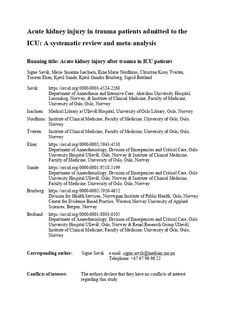| dc.contributor.author | Søvik, Signe | |
| dc.contributor.author | Isachsen, Marie Susanna | |
| dc.contributor.author | Nordhuus, Kine Marie | |
| dc.contributor.author | Tveiten, Christine Kooy | |
| dc.contributor.author | Eken, Torsten | |
| dc.contributor.author | Sunde, Kjetil | |
| dc.contributor.author | Brurberg, Kjetil Gundro | |
| dc.contributor.author | Beitland, Sigrid | |
| dc.date.accessioned | 2020-02-07T09:01:47Z | |
| dc.date.available | 2020-02-07T09:01:47Z | |
| dc.date.created | 2019-04-03T10:11:21Z | |
| dc.date.issued | 2019 | |
| dc.identifier.citation | Søvik, S., Isachsen, M. S., Nordhuus, K. M., Tveiten, C. K., Eken, T., Sunde, K., . . . Beitland, S. (2019). Acute kidney injury in trauma patients admitted to the ICU: A systematic review and meta-analysis. Intensive Care Medicine, 45(4), 407-419. | nb_NO |
| dc.identifier.issn | 0342-4642 | |
| dc.identifier.uri | http://hdl.handle.net/11250/2640189 | |
| dc.description | This is a post-peer-review, pre-copyedit version of an article published in Intensive Care Medicine. The final authenticated version is available online at: https://doi.org/10.1007/s00134-019-05535-y | nb_NO |
| dc.description.abstract | Purpose
To perform a systematic review and meta-analysis of acute kidney injury (AKI) in trauma patients admitted to the intensive care unit (ICU).
Methods
We conducted a systematic literature search of studies on AKI according to RIFLE, AKIN, or KDIGO criteria in trauma patients admitted to the ICU (PROSPERO CRD42017060420). We searched PubMed, Cochrane Database of Systematic Reviews, UpToDate, and NICE through 3 December 2018. Data were collected on incidence of AKI, risk factors, renal replacement therapy (RRT), renal recovery, length of stay (LOS), and mortality. Pooled analyses with random effects models yielded mean differences, OR, and RR, with 95% CI.
Results
Twenty-four observational studies comprising 25,182 patients were included. Study quality (Newcastle–Ottawa scale) was moderate. Study heterogeneity was substantial. Incidence of post-traumatic AKI in the ICU was 24% (20–29), of which 13% (10–16) mild, 5% (3–7) moderate, and 4% (3–6) severe AKI. Risk factors for AKI were African American descent, high age, chronic hypertension, diabetes mellitus, high Injury Severity Score, abdominal injury, shock, low Glasgow Coma Scale (GCS) score, high APACHE II score, and sepsis. AKI patients had 6.0 (4.0–7.9) days longer ICU LOS and increased risk of death [RR 3.4 (2.1–5.7)] compared to non-AKI patients. In patients with AKI, RRT was used in 10% (6–15). Renal recovery occurred in 96% (78–100) of patients.
Conclusions
AKI occurred in 24% of trauma patients admitted to the ICU, with an RRT use among these of 10%. Presence of AKI was associated with increased LOS and mortality, but renal recovery in AKI survivors was good. | nb_NO |
| dc.language.iso | eng | nb_NO |
| dc.publisher | Springer | nb_NO |
| dc.subject | acute kidney injury | nb_NO |
| dc.subject | wounds and injuries | nb_NO |
| dc.subject | critical illness | nb_NO |
| dc.subject | risk factors | nb_NO |
| dc.subject | mortality | nb_NO |
| dc.subject | systematic review | nb_NO |
| dc.title | Acute kidney injury in trauma patients admitted to the ICU: a systematic review and meta-analysis | nb_NO |
| dc.type | Journal article | nb_NO |
| dc.type | Peer reviewed | nb_NO |
| dc.description.version | acceptedVersion | nb_NO |
| dc.subject.nsi | VDP::Medisinske Fag: 700::Klinisk medisinske fag: 750::Nefrologi, urologi: 772 | nb_NO |
| dc.source.pagenumber | 407-419 | nb_NO |
| dc.source.volume | 45 | nb_NO |
| dc.source.journal | Intensive Care Medicine | nb_NO |
| dc.source.issue | 4 | nb_NO |
| dc.identifier.doi | 10.1007/s00134-019-05535-y | |
| dc.identifier.cristin | 1689905 | |
| cristin.unitcode | 203,11,12,0 | |
| cristin.unitname | Senter for kunnskapsbasert praksis | |
| cristin.ispublished | true | |
| cristin.fulltext | original | |
| cristin.qualitycode | 1 | |
